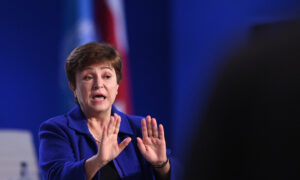IMF Pushes Global Central Bank Digital Currency Platform as Cashless Trend Builds Steam

The International Monetary Fund (IMF) is working on a platform that would allow various central bank digital currencies (CDBCs) to interoperate on a global scale, which comes amid a broader push toward cashless societies and concerns about risks to freedoms.
IMF managing director Kristalina Georgieva told conference participants on Monday in Rabat, Morocco, that the transnational agency is developing a global platform for central bank controlled digital currencies.
“CBDCs should not be fragmented national propositions … To have more efficient and fairer transactions, we need systems that connect countries—we need interoperability,” Georgieva said.
“For this reason at the IMF, we are working on the concept of a global CBDC platform,” she added.
Georgieva said the IMF wants central banks to reach a consensus on a common global regulatory framework for digital currencies that would give global adoption a major boost.
The IMF believes that the absence of a global platform on which various countries’ CBDCs can interoperate would make a weaker case for their use and cryptocurrencies would step in to fill the void.
CBDCs are controlled by central banks, while cryptocurrencies are generally decentralized.
“If countries develop CBDCs only for domestic deployment, we are underutilizing their capacity,” Georgieva said, adding that “the last thing we want” is the emergence of “settlement blocks” where CBDC transactions are settled within separate ring-fenced regional frameworks.
She said that out of 114 central banks around the world that are exploring issuing national CBDCs, around 10 have already crossed the finish line and that “we will pursue relentlessly together” the development of central bank digital currencies.
A key benefit of CBDCs, Georgieva said, is that they help promote financial inclusion and make remittances cheaper.
The IMF chief’s remarks at the Morocco conference builds on prior statements that make clear the agency sees the widespread adoption of CBDCs as a near given.
Georgieva told a conference on May 1 that the trend toward CBDCs is “not going to be reversed” and so the IMF had rapidly increased its staff dealing with digital money.
CBDC in the United States
CBDC adoption in the United States has slowly gained traction in recent times, with the Biden administration releasing a paper last September that examined the possibilities of introducing a technical framework that would support a U.S. digital dollar.
“If the United States pursued a CBDC, there could be many possible benefits, such as facilitating efficient and low-cost transactions, fostering greater access to the financial system, boosting economic growth, and supporting the continued centrality of the United States within the international financial system,” said the White House Office of Science and Technology Policy, detailing the technical framework possibilities for a central bank digital currency in America.
While the Federal Reserve has not made any definitive plans to introduce a CBDC, it’s looking into the matter and has announced the imminent launch of the FedNow service, an “instant payment” platform that some say lays the groundwork for the future adoption of a CBDC.
“FedNow appears to be a prototype CBDC,” Jordan Schachtel, publisher of “The Dossier” on Substack, stated in a tweet.
“While instant, 24/7 payments seems good, there’s implications to leaning into credit-based system. FedNow can quickly transform to a surveillance system,” he wrote.
The Fed has denied that FedNow is related to the adoption of a CBDC, insisting that it is a payment system that allows businesses and individuals receive instant payments in real time.
During congressional testimony in early March, Fed chair Jerome Powell was asked by a lawmaker whether there’s an advantage to the FedNow payment system over a CBDC or stablecoins that also tout faster payment services.
“A CBDC is going to be years in evaluation,” Powell replied. “And I think we can get this into the hands of the public very quickly, and we’ll have real-time payments in this country very very soon.”
FedNow “will enable all the banks—any bank in the United States, not just the big ones—to offer instantly available funds and real-time payments to their customers,” Powell said before the House Financial Services Committee on March 8. “That’s a great thing.”
A similar private-sector payment system that offers instant settlement features like FedNow has been around since 2017.
The U.S. government will use the current banking crisis to promote a central bank digital currency (CBDC), warned presidential hopeful Robert F. Kennedy, Jr. The candidate has come out in opposition to CBDCs in the United States, warning that its adoption would heighten financial surveillance and threaten basic freedoms.
“CBDCs grease the slippery slope to financial slavery and political tyranny. While cash transactions are anonymous, a #CBDC will allow the government to surveil all our private financial affairs,” Kennedy wrote in a tweet on April 5.
“The central bank will have the power to enforce dollar limits on our transactions, restricting where you can send money, where you can spend it, and when money expires.
Some Fed officials have warned that CBDCs could pose risks to the country. During a speech on April 18, for example, Federal Reserve governor Michelle W. Bowman stated that safeguarding privacy is a “top concern” when it comes to CBDCs.
“In thinking about the implications of CBDC and privacy, we must also consider the central role that money plays in our daily lives, and the risk that a CBDC would provide not only a window into, but potentially an impediment to, the freedom Americans enjoy in choosing how money and resources are used and invested,” Bowman said at the time.
Threat to ‘Core Freedoms’
In contrast to the view of the IMF and others that central bank controlled digital money has upsides, a recent analysis from the Cato Institute found that CBDCs pose a foundational risk to America’s economic systems while offering few benefits.
“While CBDC proponents present many potential benefits, those benefits do not stand up to scrutiny,” the think tank stated in an April analysis.
Proponents of CBDCs routinely cite the promotion of financial inclusion, faster payments, making fiscal policies easier to implement, and in the case of a U.S. central bank digital currency, it would help preserve the greenback’s status as a world reserve currency.
Yet the Cato analysis says all four do not stand up to scrutiny.
On financial inclusion, the think tank said that the push for CBDCs as a solution fails to take into account the fact that there are private sector innovations taking place in this regard and that it doesn’t address the needs of the unbanked.
As to the faster payments argument, Cato analysts acknowledged that speeding up transactions is a “noble effort,” but that “a CBDC would fail to provide a unique, or even additional, benefit compared with the existing developments in the private sector.”
The think tank also dismissed the argument that a U.S. CBDC would help preserve the greenback’s status as the world’s reserve currency as the dollar’s attraction is not based on one particular financial technological platform or another but on factors like property rights and a strong economy.
“The dollar’s renowned status is owed to the strength of the American economy and its legal protections for private citizens relative to most other countries, not the specific technology enabling electronic transfers,” Cato analysts wrote.
The final argument—that a CBDC would help with the implementation of monetary and fiscal policy—also falls short, according to Cato, which called the idea that a digital dollar would let policymakers fine-tune the economy both “sanguine” and “concerning.”
At the same time, while a CBDC would not offer any unique benefits compared with existing technologies, it would pose “serious risks,” the think tank warned.
This includes a “substantial” threat to financial privacy, financial freedom, as well as the foundation of the banking system itself.




